The best mountain bike forks will help improve your bike's traction, comfort and control. A suspension fork might be one of the priciest upgrades you make to your bike, but it will potentially be one of the most effective. Even when buying a complete bike, the fork it comes with is a serious consideration.
You’ll want either a suspension fork that irons out the harshest trail feedback, helping your hands to last longer whatever bike you ride, or you’ll want the fork to sit smoothly into the first part of its travel to keep your front wheel stuck to the ground.
You’ll also need enough stiffness to provide accurate and predictable steering, and enough adjustability to fine-tune the fork to your needs, but not so much that it’s a nightmare to set up. You'll probably want it to be as light as possible too, and hopefully not cost the earth.
We’ve tested forks to suit a broad range of budgets, but if you're looking for great performance at a more affordable price, check out our pick of the best budget mountain bike forks.
You can read how we test mountain bike forks and our full mountain bike suspension forks buyer's guide at the end of this article.
Editor's note: This list was updated on 3 January 2025.
Best mountain bike forks in 2025
RockShox Lyrik Ultimate MY25
SQUIRREL_TEXT_13121219

- Price: £1,079 / $1,099 / €1,199 as tested
- Pros: Smooth and supple ride; good mid-stroke support; luxuriously plush; easy to tune and set up
- Cons: None
RockShox's Lyrik Ultimate MY25 offers impressive performance over a wide range of trail types.
The new Charger 3.1 is a masterpiece in damping technology, with the fork having class-leading smoothness and deep-travel management.
Our tester found the Lyrik Ultimate to be one of the best forks they've ridden, describing it as irreproachable.
The fork is easy to set up, with high levels of adjustability offered in the form of high- or low-speed compression damping.
- Read more: RockShox Lyrik Ultimate MY25 review
Specs
Wheel-size/travel options: 29in and 27.5in with 140mm, 150mm or 160mm | Weight: 2,044g (29in x 150mm)
SQUIRREL_13121219
RockShox SID Ultimate 3P
SQUIRREL_TEXT_13086850

- Price: £1,069 / $999 / €1,199 as tested
- Pros: Initially very sensitive; remains controlled in rough terrain
- Cons: TwistLoc remote grips don't have lock-on option
The SID Ultimate 3P is the latest top-level cross-country fork from RockShox, offering a more refined and capable ride feel than the fork it replaced.
Its new Charger Race Day 2 damper gives the fork three positions, which can be switched between ‘open’, ‘pedal’ and ‘lock’ modes via the crown-top lever or optional TwistLoc remote (£119/$117/€133).
We found 'open' and 'pedal' to be our most frequented modes, rarely using the 'lock' mode unless slugging up road ascents and the odd fireroad.
The SID Ultimate 3P is keen to sink into the first few millimetres of travel without hesitation, making for a supple ride with a smooth, ground-hugging feel over small bumps.
Its mid-stroke support builds progressively, with the ramp-up near the end of the travel remaining calm on big hits.
The new 35mm chassis enables the fork to attack fast, technical descents with precision, with only some flex being detected on steeper turns with fast catch berms that would challenge most trail forks.
- Read more: RockShox SID Ultimate 3P review
Specs
Wheel-size/travel options: 110mm and 120mm (29in) | Weight: 1,600g (29in x 120mm)
SQUIRREL_13086850
Fox 36 Podium Gold GRIP X
SQUIRREL_TEXT_13096189

- Price: £1,259 / $1,199 / €1,449 as tested
- Pros: Great support in the mid and end stroke; dives less than the previous generation; lightweight; supple
- Cons: Pricey; travel could be used more effectively
Fox's 36 Podium Gold GRIP X impresses with its new GRIP X damper providing plenty of support that makes overwhelming the fork almost impossible – even when riding on the most technical trails.
The travel is accessed smoothly, but it lacks the outright plushness of its competitors off the top – especially when riding in a passive position.
Despite this, the 36 Podium Gold GRIP X remains a fantastic fork and one aggressive riders will like due to its support and anti-dive characteristics.
- Read more: Fox 36 Podium Gold GRIP X review
Specs
Wheel-size/travel options: 27.5in with 160 and 150mm; 29in with 160mm | Weight: 2,015g (29in x 150mm)
SQUIRREL_13096189
Formula Belva
SQUIRREL_TEXT_13148845

- Price: £1590 as tested
- Pros: Great performance; smart tuning capabilities at home or in the car park; direct and accurate handling
- Cons: Dual-crown design won’t work on all bikes; 160mm brake mount; coil negative spring won’t suit heavier riders; price
Formula has done an incredible job with the Belva downhill fork. It balances smooth and plush travel with impressive levels of support.
That small-bump sensitivity is great and I was thoroughly impressed by the fork's composure and confidence through all types of trails and terrain – rattle the Belva into a rough rock garden and it delivered precision and comfort single-crown forks struggle to match.
Due to frame-compatibility issues, it won’t be for everyone. However, those who can fit it, especially average and lighter-weight riders, will be getting a great fork. Its handling is direct and accurate, while its travel is plush yet supportive. Plus, its CTS valves provide a tunability other forks can’t match.
- Read more: Formula Belva review
Specs
Wheel-size/travel options: 29in with 170 or 180mm | Weight: 2,376g (29in x 170mm)
SQUIRREL_13148845
Manitou Mattoc Pro
SQUIRREL_TEXT_13079619
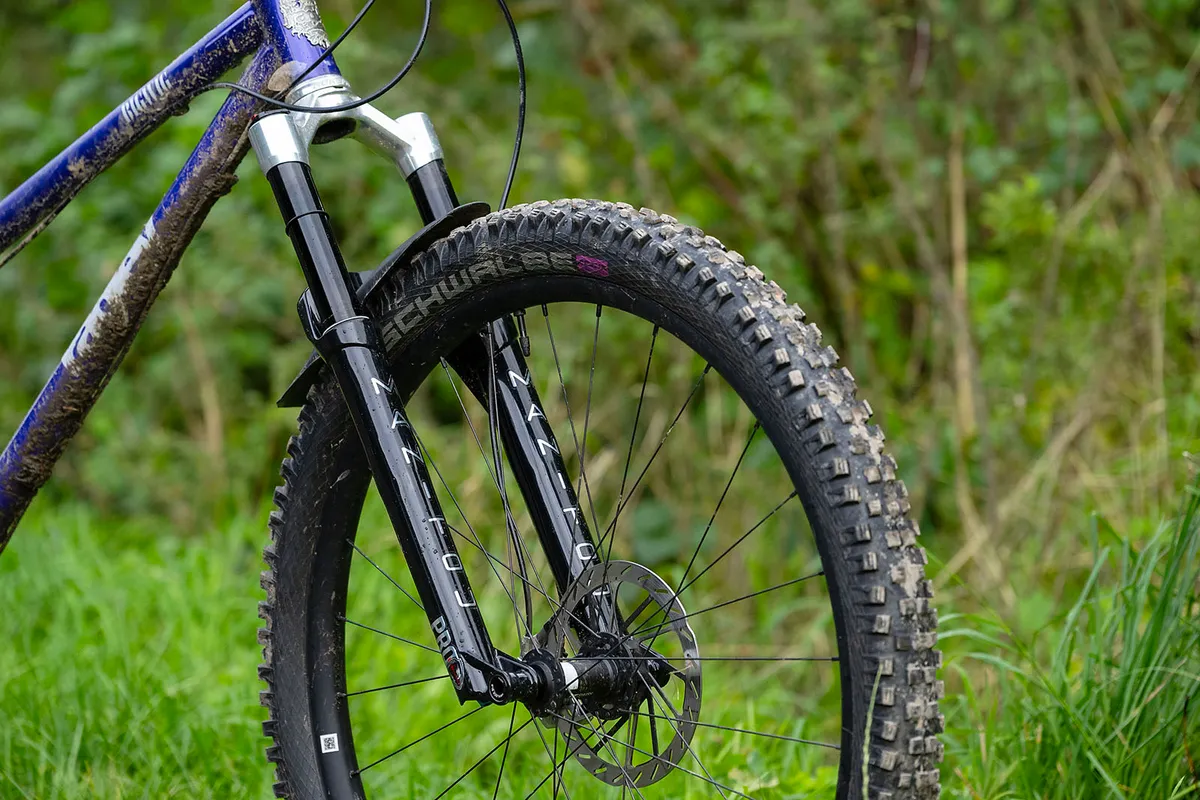
- Price: £1,323 / $1,050 / €1,260 as tested
- Pros: Lovely feel through travel; easily adjustable; competitive weight
- Cons: Air valve access could be easier; Hexlock axle isn’t quite as intuitive as competitors
The Mattoc Pro impressed us with its impeccable suppleness and great end-of-stroke control.
Manitou has given the fork plenty of adjustment with an MC2 damper, with hydraulic bottom-out in the stanchion offering high and low-speed compression and single rebound adjustment.
All this tech pays dividends, with the Mattoc Pro offering plenty of grip and comfort, with ample control late into the stroke and plenty of usable adjustment.
The Hexlock axle is more difficult to use than other securing axles, with a hand needed to balance the bike, push the axle and turn the Allen key from the other side of the fork.
We also found the air valve to be in an awkward position at the bottom of the fork, making it difficult to use with some shock pumps.
- Read more: Manitou Mattoc Pro review
Specs
Wheel-size/travel options: 27.5in and 29in with 120mm or 140mm | Weight: 1,797g (29in x 140mm)
SQUIRREL_13079619
Öhlins RXF36 m.2
SQUIRREL_TEXT_13148466

- Price: £1,310 / $1,245 / €1,520 as tested
- Pros: Impressive ramp-up; good adjustment; amazing mid-stroke support
- Cons: Weight; off-the-top compression could be smoother
The RXF36 m.2's damper impressed us with smooth off-the-top travel and other-worldly mid-stroke support.
It's heavier and more expensive than its competitors, and the RXF36 m.2 offers plenty of adjustability, enabling you to set it up exactly how you desire.
We found Öhlins' recommended setting to be a little off when setting up the fork, so be prepared to play around a little to find your optimum setup.
- Read more: Öhlins RXF36 m.2 review
Specs
Wheel-size/travel options: 29in with 140mm, 150mm, 160mm or 170mm; 27.5in with 150mm, 160mm or 170mm | Weight: 2,126g (29in x 150mm)
SQUIRREL_13148466
Öhlins RXF38 m.2
SQUIRREL_TEXT_13148850
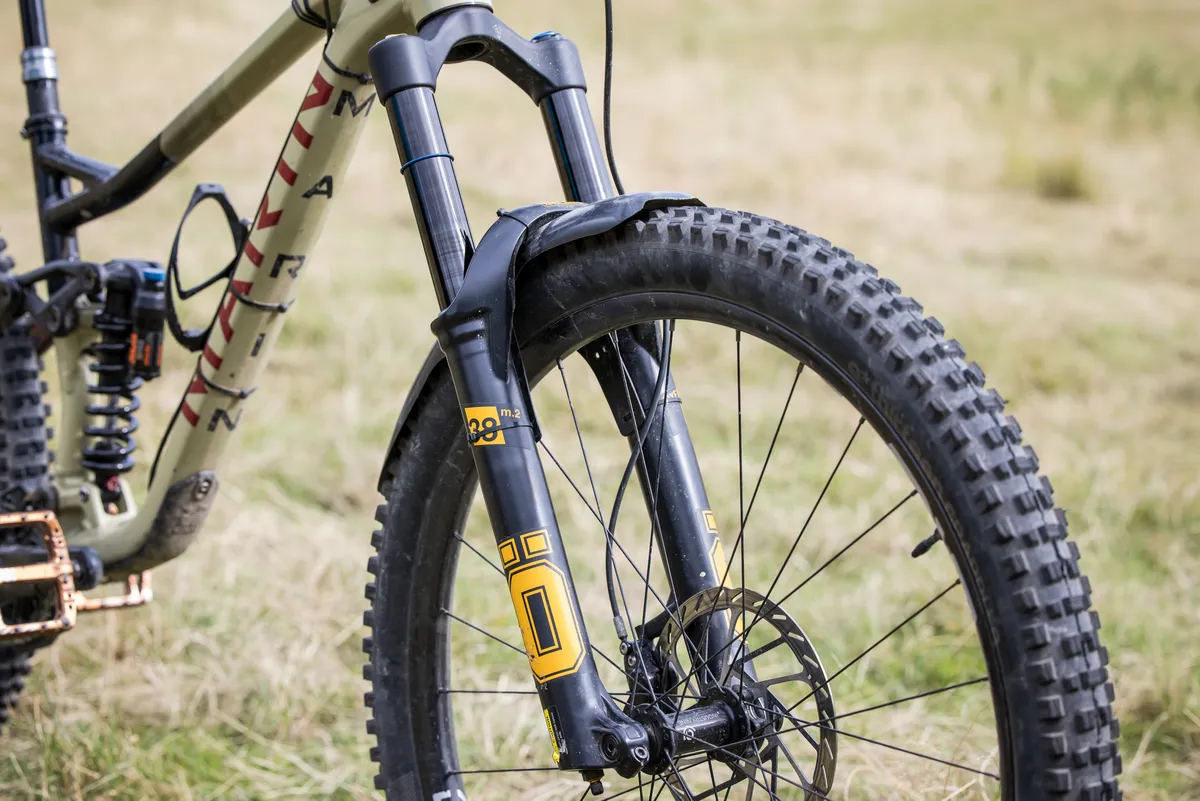
- Price: £1,450 / $1,450 as tested
- Pros: Smooth and fluttery off-the-top; tunable bottom-out
- Cons: Rebound damping re-tune might be needed
The RXF38 has impressive off-the-top sensitivity, minimising trail chatter and providing huge amounts of comfort and grip.
Mid-size hits such as brake bumps are catered for with buckets of support. The damper controls the impacts with a calmness that enables you to focus on what's down the trail rather than beneath your front wheel, leading to more speed.
The fork handled compressions well, never once diving under hard braking, which gave confidence to weight the front wheel into catch berms and steep sections of trail.
The rebound damping on our test fork was a little hard, which may be a problem for lighter riders, but the brand offers various tunes, so finding the right one shouldn't be hard.
It was also a difficult fork to set up, with a negative spring volume-reducer spacer installed in the fork from the factory that wasn't mentioned in the manual.
- Read more: Öhlins RXF38 m.2 review
Specs
Wheel-size/travel options: 29in with 160mm, 170mm or 180mm | Weight: 2,354g (29in x 170mm)
SQUIRREL_13148850
Öhlins RXC34 M.1 Carbon

- Price: £1,499 / $1,390 / €1,695 as tested
- Pros: Excellent damping control; supple over small bumps; trail-bike infused steering precision; lightweight; more adjustable than rivals
- Cons: Pinch-bolted axle isn’t the fastest to remove; difficult to see rebound adjust sticker, more expensive than the competition
Öhlins’ new RXC34 M.1 Carbon fork blends a trail-bred chassis with an all-new cross-country optimised damper. It's an impressive performer, taking the fight to the best cross-country forks you can buy right from the off.
It is lightweight, has an exceptionally stiff chassis and performs its duties in a smooth, controlled and trail-calming manner.
You’ll pay a hefty price and have to live with one or two usability niggles, but the result is an incredibly capable fork that stands as one of the best short-travel suspension forks you can buy.
- Read more: Öhlins RXC34 M.1 Carbon review
Specs
Wheel-size/travel options: 29in with 120mm | Weight: 1,536g
RockShox BoXXer Ultimate
SQUIRREL_TEXT_13082883

- Price: £2,029 / $1,899 / €2,279 / AU$3,265 as tested
- Pros: New chassis gives precise handling; DebonAir+ twin tube spring gives plenty of support without a firm spike or ramp-up deep in the travel
- Cons: Rebound dial stiff and creaky
The RockShox BoXXer Ultimate downhill fork has 38mm stanchions which add plenty of accuracy and makes the fork hold a line well, even when traversing slippery rocks after poor line choices.
A smooth and quiet ride quality calms the front of the bike and makes the BoXXer feel reassuringly predictable, while the breakaway force of is minimal, with the fork sliding easily into its initial stoke.
The beginning of the stroke takes the sting out of small high frequency bumps impressively well, isolating your hands without losing support.
Charging through rough sections reveals how composed this fork is, with the mid-stroke soaking up big hits while delivering plenty of support to push against.
There's no harsh ramp-up or firmness present at the end of stroke, making big drops and high speed compressions reassuringly composed as the linear nature of the fork feels like it's only using the travel it needs.
After some use, the rebound dial on our early test model became stiff and creaky, but this didn't hinder performance.
- Read more: RockShox BoXXer Ultimate review
Specs
Wheel-size/travel options: 29in and 27.5in with 200mm | Weight: 2,840g (29in x 200mm) claimed
SQUIRREL_13082883
RockShox ZEB Ultimate
SQUIRREL_TEXT_13089710

- Price: £1,119 / $1,253 / €1,159 as tested
- Pros: Easy to make meaningful adjustments; good mid-stroke support
- Cons: Lighter riders may need a re-tune
RockShox's ZEB Ultimate is one of the best suspension forks on offer, with seriously impressive composure and control on rough trails.
Aimed at enduro racers, the ZEB Ultimate has best-in-class small-bump sensitivity with a supple and silent feel that does a great job of tracking trail imperfections,
There is plenty of support deeper into the travel, delivering a calm and composed ride through steep gnarly sections where your weight is over the front of the bike.
Its progression is very gradual through the entire stroke, giving confidence towards the end, where other forks can feel harsh.
The dials enable high levels of adjustment, with high- and low-speed compression all tuneable from the crown of the fork.
We found our test tune to not compliment lighter riders, with all adjustments needing to be fully open for the desired fork setup, reducing overall tunability
- Read more: RockShox ZEB Ultimate review
Specs
Wheel-size/travel options: 29in and 27.5in with 150mm, 160mm, 170mm, 180mm or 190mm | Weight: 2,265g (claimed)
SQUIRREL_13089710
Cane Creek Helm MKII
SQUIRREL_TEXT_13086142
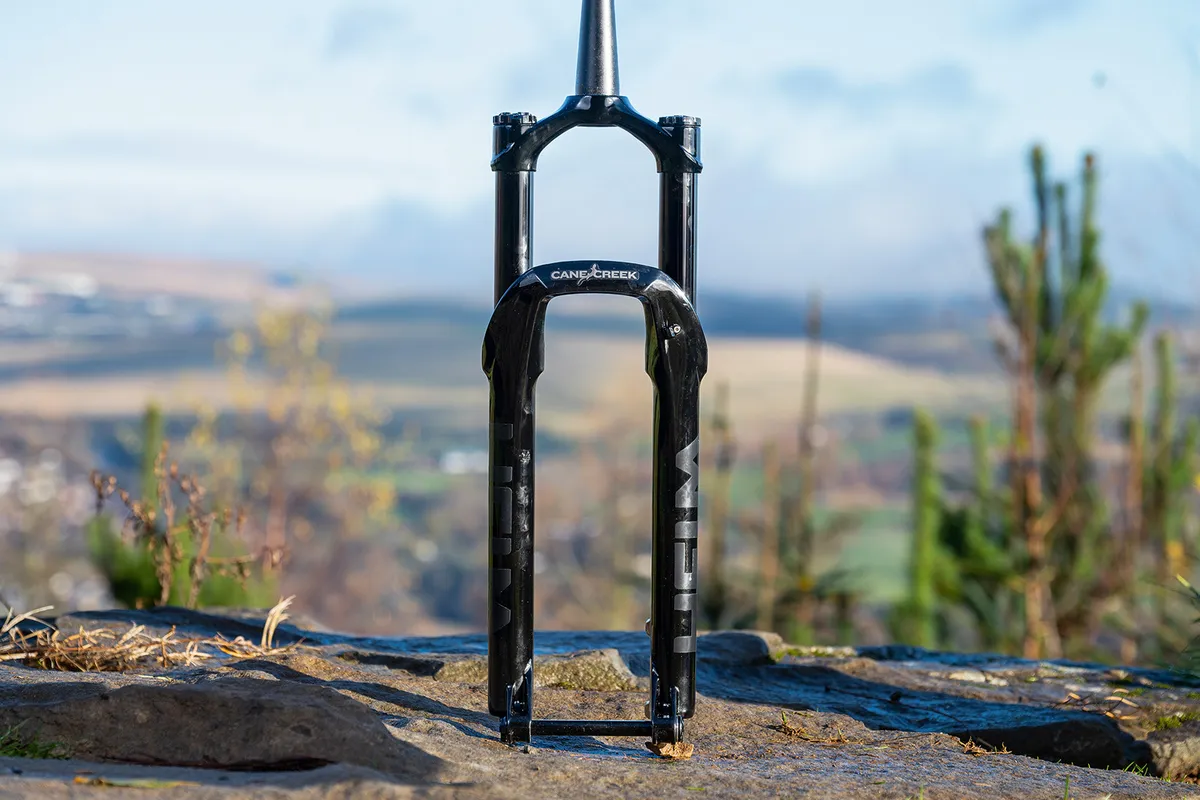
- Price: £1,100 / $1,100 / AU$1645 as tested
- Pros: High levels of adjustability; supple ride feel
- Cons: Not the most supportive in the mid-range
The Helm MKII has 35mm stanchions, which felt accurate through rocky sections with no significant flex or binding.
You get external low- and high-speed compression and low-speed rebound-damping adjustment.
The negative air spring is equalised manually from the positive spring, making it easy to tune the fork's progression. It takes a little figuring out to set up the fork, but once you get it dialled in, it’s an impressive piece of kit.
The Helm MKII is wonderfully supple through the initial part of its travel, so takes a lot of the sting and buzz out of the trails.
Deeper into the mid-stroke, it feels as though it relies on its spring for support more than its damping, which makes for a very plush ride.
It doesn’t have the most supportive mid-stroke, but there’s a decent range of low-speed compression damping should you want to wind some on. Bigger hits are dealt with comfortably, too.
Whether you’re hitting heavy compressions or landing massive drops, the Helm MKII’s progression builds consistently throughout its travel, which makes for a predictable-feeling ride.
- Read more: Cane Creek Helm MkII Air review
Specs
Wheel-size/travel options: 29in and 27.5in with 130mm, 140mm, 150mm or 160mm | Weight: 2,008g (29in)
SQUIRREL_13086142
Cane Creek Helm MKII Coil
SQUIRREL_TEXT_13095191
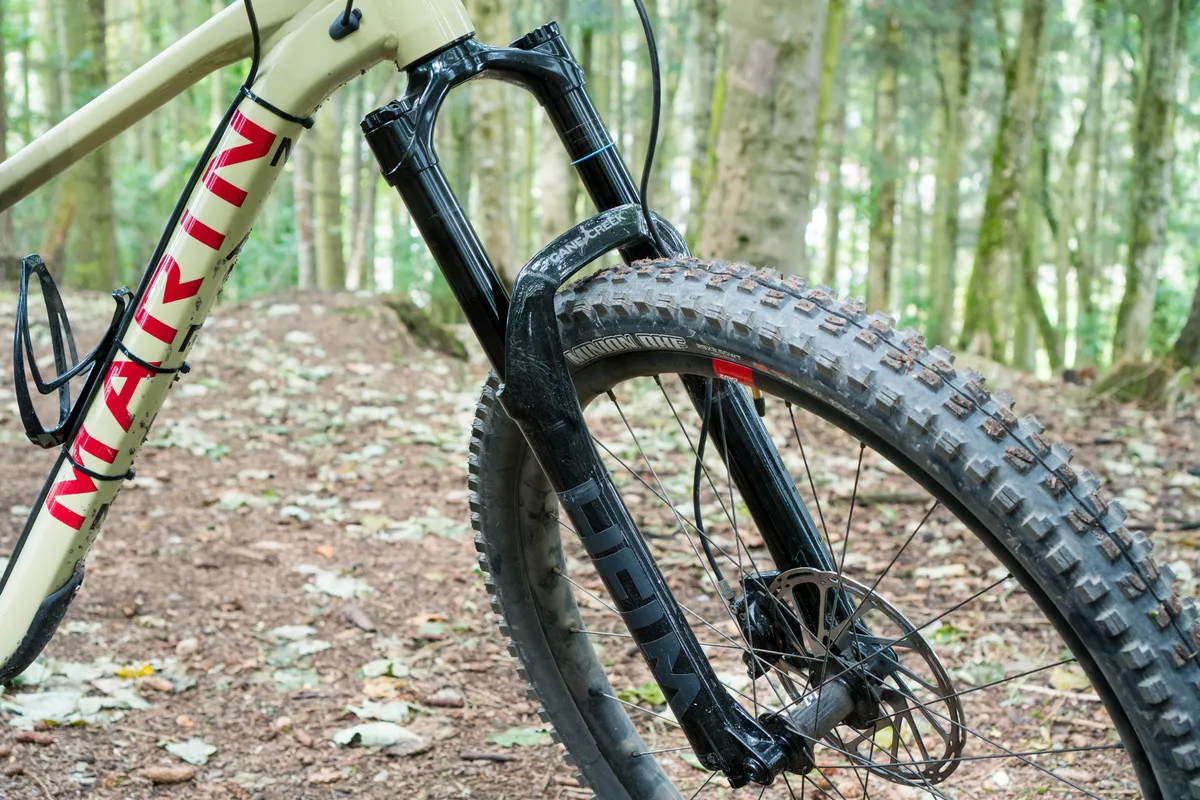
- Price: £1,049.99 / $1,049.99 as tested
- Pros: Supremely supple; easy to adjust; good bottom-out resistance
- Cons: Could be over-damped for lighter riders; tyre clearance
Cane Creek's Helm MKII Coil impresses with its suppleness, ironing out small-bump chatter and isolating your hands from well-worn trails.
With four spring options to choose from for riders weighing 45 to 100kg, we found the suggested spring to be too soft, with the desired support still missing even when we maxxed out the low-speed compression.
After replacing the spring with the hardest available, the fork proved to be a top performer, responding well to being pushed hard on rough, gnarly terrain.
In its open settings, the fork becomes very firm, which limits the adjustability real-world usage.
We also found the tyre clearence to be quite tight, with Cane Creek giving the Helm a maximum tyre clearance of 2.5in on the 29in model. This made it difficult to attach a variety of mudguards to the fork.
- Read more: Cane Creek Helm MKII Coil review
Specs
Wheel-size/travel options: 29in and 27.5in with 130mm, 140mm, 150mm or 160mm | Weight: 2,330g (29in x 160mm)
SQUIRREL_13095191
Formula Selva R
SQUIRREL_TEXT_13148851

- Price: £1,200 / AU$2,099 as tested
- Pros: Wide-ranging and user-friendly adjustability
- Cons: Narrow arch makes fitting mudguards tough with Velcro straps; 160mm brake mount
Formula’s Selva R has impressive adjustability, enabling you to tune it more than most other forks.
The positive and negative air springs are inflated independently, and you can reduce end-stroke progression with the Neopos compressible-foam volume spacer.
You also get Formula’s Compression Tuning System (CST), consisting of swappable valves that change the compression tune, giving you seven different options.
The 2Air system is useful for fine-tuning how the initial part of the travel feels. This gives the fork plenty of small-bump sensitivity, enabling the wheel to hug the ground and making it easy to find grip on slippery trails.
Suppleness over square-edged hits is impressive, too.
We found the Selva R calmed the ride and kept the front end stable, with no harsh spikes deeper in the travel. Over braking bumps, the rebound is fast enough to keep it from packing down and becoming harsh.
Even without the volume spacer, progression was impressive, and we never used full travel, so could run lower pressures to give even more bump-swallowing ability.
Don’t let the narrow 35mm stanchions deter you – whether in high-load berms or big compressions, the Selva R stays composed.
- Read more: Formula Selva R review
Specs
Wheel-size/travel options: 29in and 27.5in with 120mm, 130mm, 140mm, 150mm 160mm or 170mm | Weight: 2.11kg (29in)
SQUIRREL_13148851
Manitou Mezzer Expert
SQUIRREL_TEXT_13085974
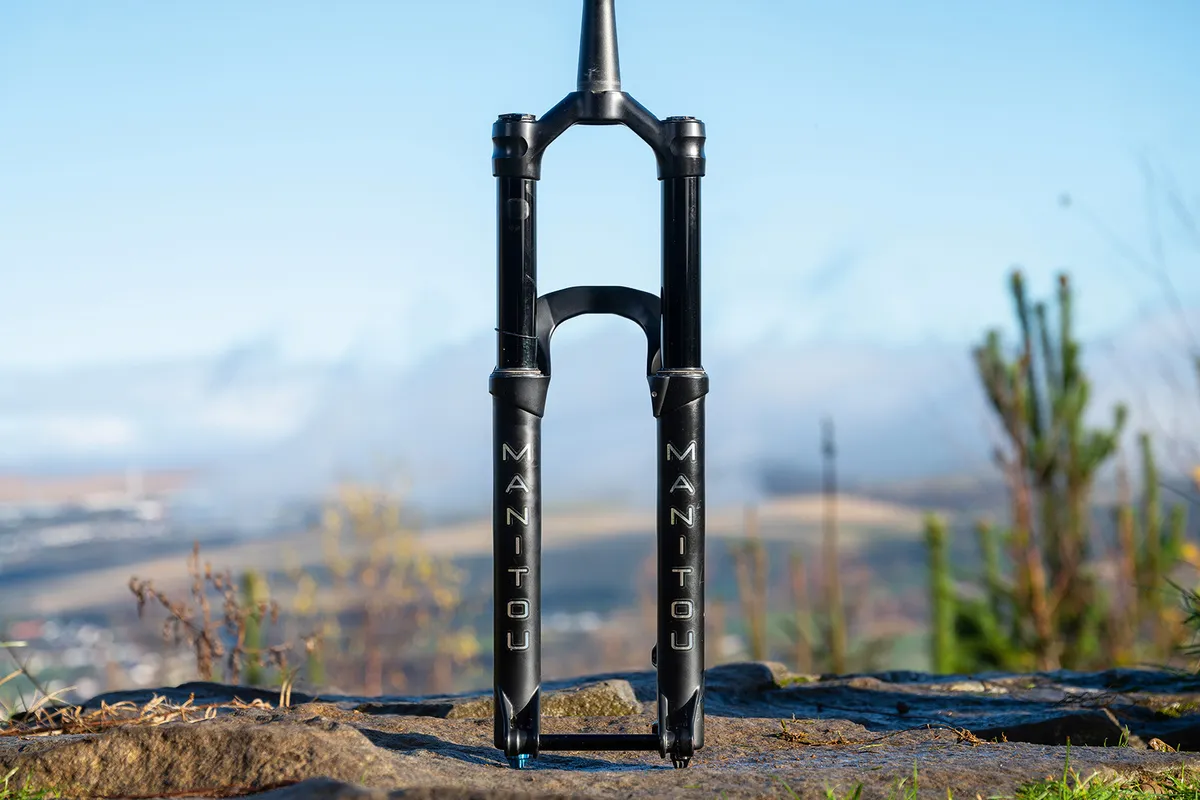
- Price: £700 / $815 / €864 / AU$1234 as tested
- Pros: Impressive performance for the money
- Cons: Support mediocre; digital pressure gauge is a necessity for setup
The Mezzer Expert comes with Manitou’s ‘Reverse Arch’, which sits behind, rather than in front of, the 37mm stanchions.
External adjustment is limited to a six-position low-speed compression-damping dial, a lockout and a low-speed rebound adjuster.
There’s also a self-equalising negative spring and an ‘Incremental Volume Adjuster’ (IVA), which enables you to change the positive air chamber volume by rearranging self-contained spacers.
The Reverse Arch’s appearance may divide opinion, but it works well enough – the Mezzer Expert’s accuracy through technical sections is good, and we never noticed any binding under high-load turns or sharp direction changes, either.
The fork feels stiff, but not harsh. Blasting along chattery trails, its low breakaway force means it sits comfortably in its sag and soaks up small bumps well, providing tons of grip and confidence in corners and root or rock sections.
Support is mediocre, but it can use its travel and recover from repeated hits quickly. Progression to the end-stroke builds smoothly, with no sharp spike in ramp-up.
We were never hesitant landing drops or ploughing into deep compressions. Pummel through a rock garden and the fork lends a calmness to the front end that helps boost confidence.
- Read more: Manitou Mezzer Expert review
Specs
Wheel-size/travel options: 29in and 27.5in with 140mm, 150mm, 160mm, 170mm or 180mm | Weight: 2.09kg (29in)
SQUIRREL_13085974
Öhlins RXF34 m.2
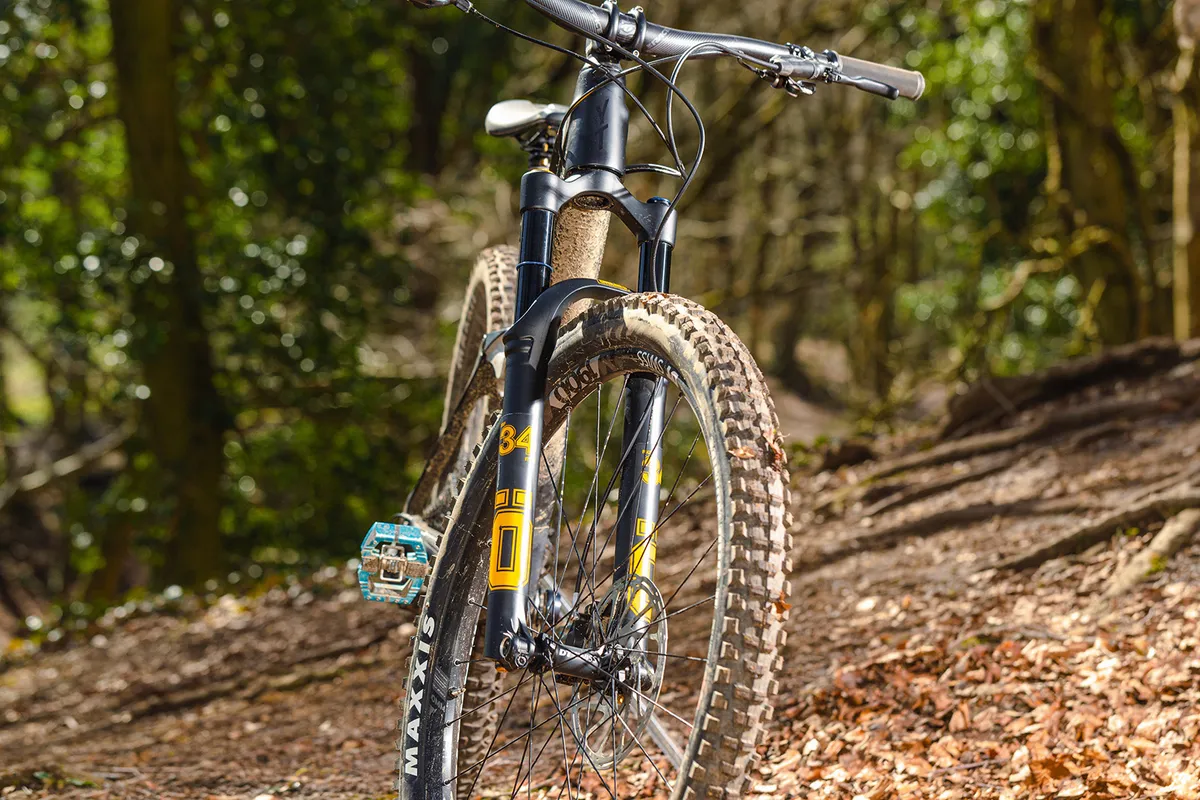
- Price: £1,185 as tested
- Pros: Usable range of adjustments; plenty of support without feeling harsh
- Cons: Pricey
Öhlins' RXF34 m.2 is aimed at downcountry riding with weight saving as a priority.
The RXF34 m.2 uses a traditional positive chamber and self-equalising negative chamber in the spring, with volume spacers to increase progression, rather than Öhlins' three-chamber design.
We found the chassis to deliver precise steering, with the RXF34 m.2 able to hold a line through tough rocky and rooty terrain better than other lightweight forks.
The mid-stroke has plenty of support, and even with the low-speed compression open the fork remained composed though compressions and high-load corners.
We found no harshness when using the full range of travel, with the fork remaining smooth with zero spiking.
- Read more: Öhlins' RXF34 m.2 review
Specs
Wheel-size/travel options: 29in with 120mm or 130mm | Weight: 1740g (130mm)
How we test the best mountain bike suspension forks
We’ve tested mountain bike forks since the very beginning of BikeRadar in 2007.
In that time, we’ve tracked every major change in all disciplines and kept up to date with the latest technology, release after release.
While we cover more mainstream fork brands such as RockShox and Fox, we also try to test a wide range of niche and specialist forks.
Working alongside our sister brand MBUK, our reviews are always editorially independent – with no exceptions.
Our reviewers comprehensively test each fork, pushing them to their limits – and sometimes past them – depending on the discipline they’re designed for.
Our reviewers comprehensively test all products in the real world, always reflecting on performance, value and the wider market when delivering their verdicts and review ratings.
How do I choose a mountain bike fork?

Just like your choice of mountain bike, your choice of a suspension fork should take into consideration the type of rider you are and the severity of the terrain you wish to cover.
There are a multitude of mountain bike forks on the market, from the likes of RockShox and Fox, grouped into sub-categories each intended for a specific use case.
The main differences between the categories are weight and stiffness. Heavier, stiffer forks are favoured by aggressive trail and enduro riders, while lighter forks are popular amongst those riders who value weight savings and don’t require the extra rigidity of a heavier fork, such as XC riders.
Long-travel trail and enduro forks achieve increased stiffness through an all-round beefier chassis, with thicker stanchion diameters (35-38mm) compared to short-travel forks, which commonly have smaller stanchions (32-34mm diameter).
While the chassis often remains similar throughout the price range, the internals housed within vary greatly, with high-end options offering improved performance and tunability over their budget counterparts.
Do all suspension forks fit all bikes?

Based on their intended use, mountain bike frames are designed with a specific suspension fork travel in mind.
Retrofitting a longer or shorter-travel fork can have a big impact on a bike’s geometry, potentially putting excessive stress on the frame. Therefore, it is not uncommon to see brands stating a maximum fork travel for their bikes, a breach of which could impact your warranty.
Increases of 10mm, swapping a 150mm fork for a 160mm option, for example, won’t usually compromise your frame’s geometry too drastically. However, we recommend you check with your frame manufacturer’s guidelines before committing to a fork swap.
How much suspension travel do I need?

How much suspension travel you need depends greatly on your riding. If you would describe yourself as a cross-country rider, enjoying big days out on relatively tame paths and trails, you will find the best balance of weight and comfort in a fork with 80 to 120mm of travel with 30 to 34mm wide stanchions.
If you love riding trail centres, with the occasional day out in the mountains thrown in, a suspension fork with 120 to 150mm of travel and 34 to 36mm width stanchions will offer you a good level of comfort and grip at a manageable weight.
If you are an enduro rider and love tackling the steepest and roughest trails around, an aggressive fork with 160 to 180 mm of travel and thick 35 to 38mm width stanchions will offer the best grip, stiffness and comfort at the cost of weight.
If you ride a freeride or downhill bike, you'll want as much travel as possible to deal with high speeds and gnarly terrain. You'll likely already be running a suspension fork with 180 to 200mm of travel with 38mm to 40mm width stanchions.
Air vs coil suspension
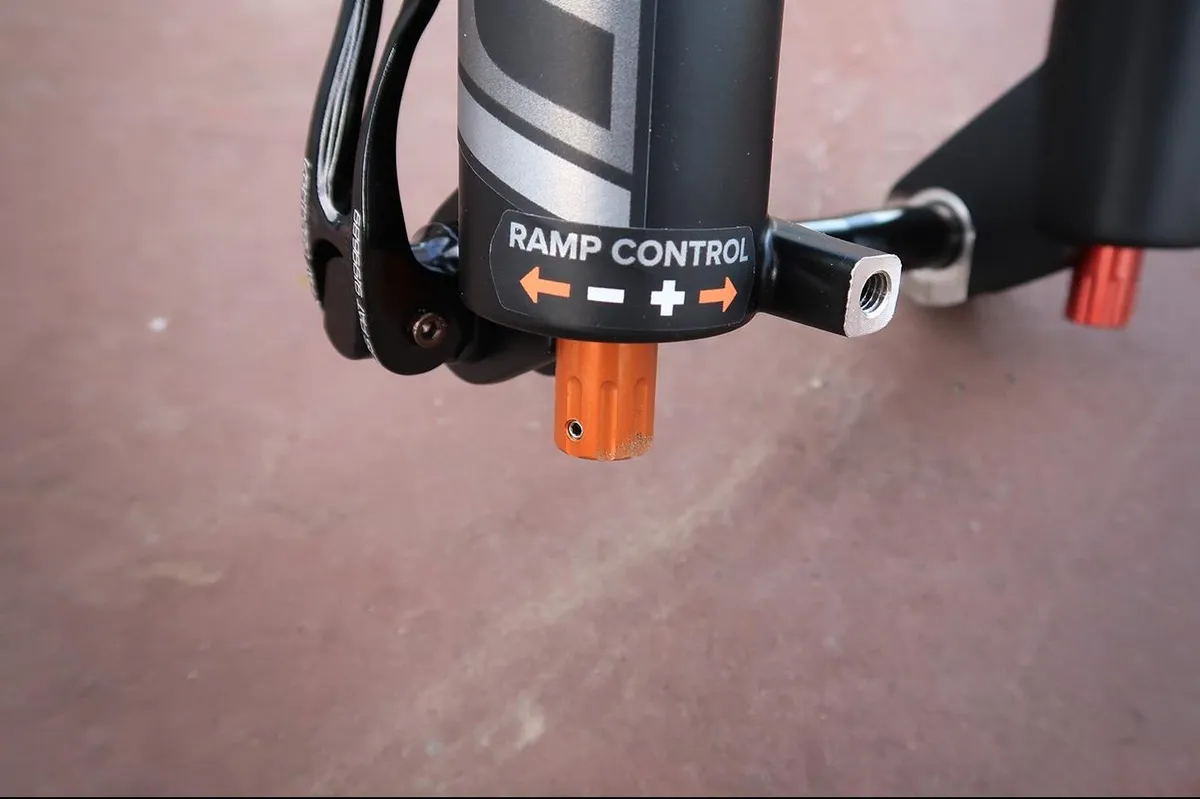
The spring in a suspension fork enables the fork to absorb bumps and impacts from the trail. It is usually housed inside the left leg of the fork and can be an air spring or a coil spring.
Coil springs are linear, which means there’s a direct relationship between how much force it takes to compress the spring and how compressed the spring is. For example, a 200lb/in spring will take 200lb of force to compress one inch, 400lb to compress two inches, 600lb to compress three inches, and so on.
They are also linear, meaning that no matter how deep it is in its travel, a coil spring will always compress the same amount under a given load.
An air spring is a sealed cartridge with an internal piston that moves as the fork absorbs an impact, reducing the volume and increasing the pressure in the chamber. Air springs are progressive, meaning that the load required to compress them increases the deeper they sit into their travel.
On modern mountain bikes, air-sprung forks are by far the more popular choice. They are a lot lighter than their coil counterparts and can be easily and accurately adjusted by raising or lowering the internal air pressure with a shock pump to find the perfect setup.
Coil-sprung forks on the other hand can only be adjusted by swapping the coil for another with a heavier or lighter spring weight, which is both costly and time-consuming.
Straight steerer vs tapered steerer
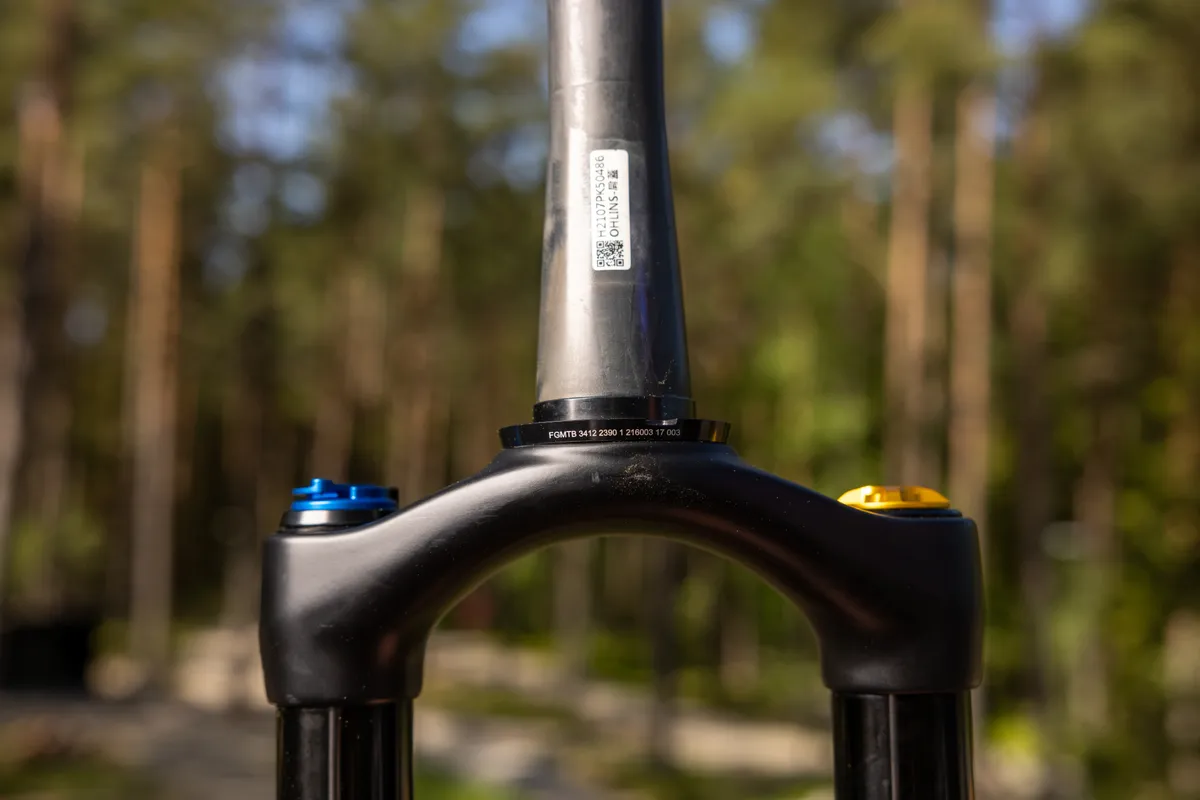
The steerer is the tube that connects the fork to the bike, fitting through the bike’s head tube before being clamped by the stem and top cap. There are two standards for suspension fork steerers.
The old steerer standard featured a 1 ⅛-inch diameter from top to bottom. These are called straight steerers.
As the name suggests, tapered steerers have a 1.5in diameter at the bottom and taper to a 1 ⅛-inch diameter at the top. Most modern mountain bikes now feature this standard, which is claimed to improve stiffness between the frame and the fork.
A couple of brands have strayed from these standards. Giant ran its Overdrive2 fork steerer system, which tapered from 1.5-1.2in for a number of years, and Cannondale (plus a few other small ebike brands) have run straight 1.5in steerer tubes.
While few bikes deviate from the regular tapered standard, if you have a Giant or a Cannondale, it might be worth checking.
If you have a bike with a tapered head tube, it is possible to fit an older fork with a straight steerer, providing you source an adaptor for the lower headset cup. Unfortunately, the same does not apply to fitting a new tapered fork to an older frame with a straight head tube.
Volume tokens/spacers

Another benefit of air-sprung suspension forks is their ability to be tuned with volume spacers, sometimes called tokens. These spacers are an inexpensive way to tune the progression of your fork.
By adding volume spacers, you effectively reduce the size of the fork’s internal air chamber, increasing the progressivity of the spring. This enables you to reduce your overall air pressure, increasing the fork’s sensitivity at the start of the stroke without compromising support and ramp-up deeper in the travel.
By removing volume spacers, you can make your fork more linear. This is especially useful for lighter riders who are struggling to use all of their travel and bottom out their fork.
What are compression and rebound damping?
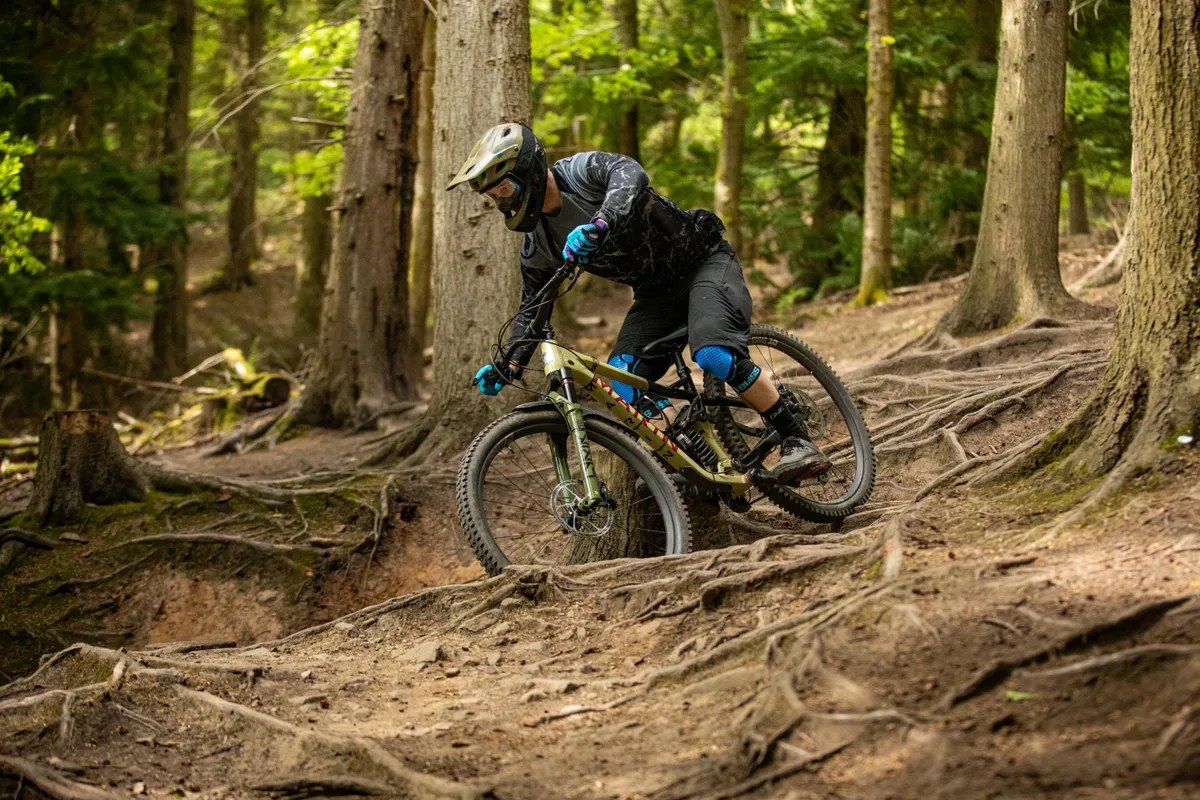
Regardless of whether you have an air or coil spring, the spring itself does a fairly simple job – it absorbs an impact and then returns to its original position.
However, without damping, it is essentially a pogo stick and not very good at delivering a controlled and predictable ride.
This is where rebound and compression damping come into play. Usually housed in the right leg of the fork, the damper is adjusted by dials at the top and bottom of the fork leg.
Rebound damping

Rebound damping controls the speed at which the spring returns after absorbing an impact. Too fast and the fork will bounce uncontrollably. Too slow, and it won’t extend in time for the next impact, making for a very harsh ride and compromising grip.
High-speed rebound damping controls how fast your fork will rebound from a big hit that uses most of the suspension travel, while low-speed rebound controls the speed through the rest of the travel.
Luckily, rebound damping can be adjusted on most quality mountain bike forks. Adding rebound damping (often marked '+' on the fork dial) slows down the return rate of the fork. Reducing rebound damping (often marked '-' on the fork dial) speeds up the return rate of the fork.
Low-speed compression damping

Low-speed compression (LSC) damping influences how the fork responds to impacts where the spring compresses slowly – think pushing into a take-off or around a berm.
Adding low-speed damping makes the fork firmer in these instances, using less travel, and can make for a more supportive and stable-feeling fork at the cost of some sensitivity on small bumps.
High-speed compression damping
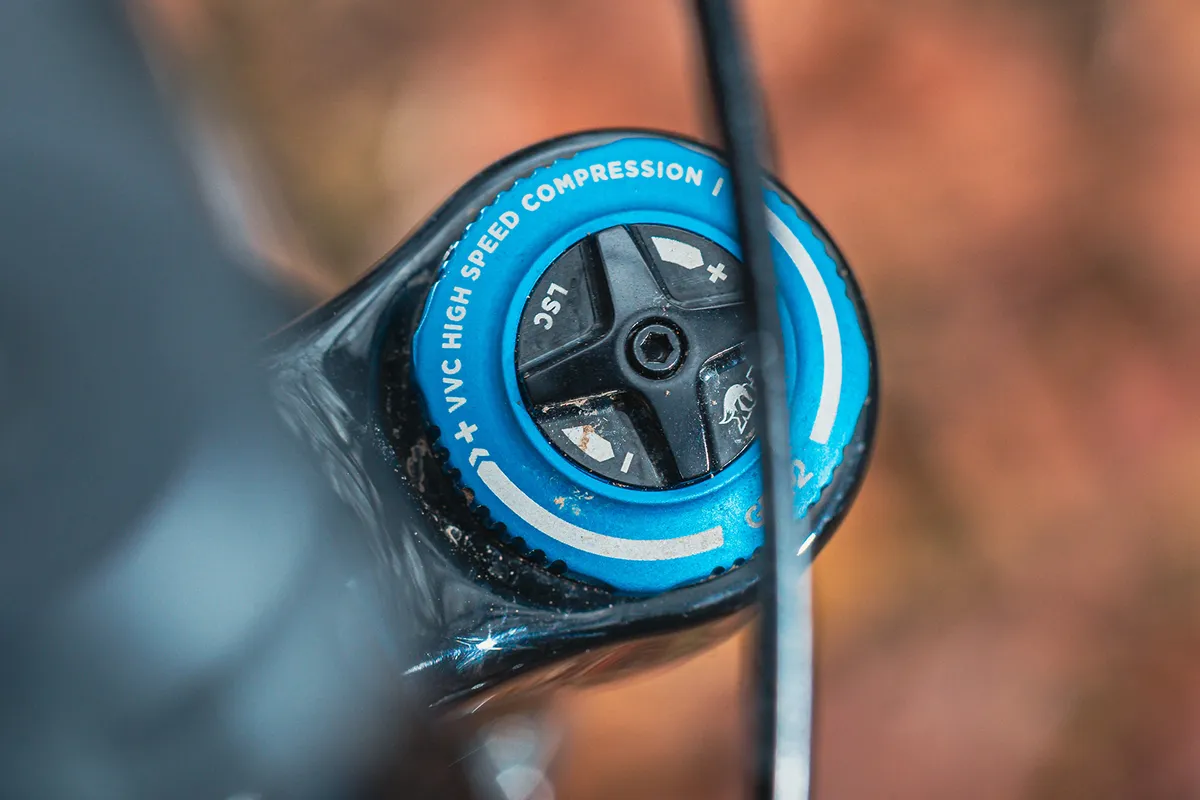
High-speed compression (HSC) damping is usually only available on high-end forks. It influences how the fork responds to impacts that make the spring compress rapidly, such as sudden compressions and big hits.
Adding high-speed compression damping helps to stop the fork blowing through all of its travel and bottoming out.
How do I know my fork size?

When considering a fork upgrade, it’s important to know the travel and size of your current fork because replacing it with something outside your frame manufacturer's parameters could void your warranty.
Suspension travel is often displayed on the rear of the fork legs, just beneath where the stanchions meet the lowers. If this isn’t the case on your particular fork, you can find the serial number under the fork crown.
The length of the stanchions can also be an indicator of how much travel a fork has. However, it isn’t always reliable because some forks don’t use their full stanchion when compressed.
Another important measurement is the axle-to-crown distance. This is measured in a direct line from the fork crown to the axle.
When measuring this distance, it's important that the fork is unsagged, so make sure the stanchions are fully extended before you grab your tape measure.

